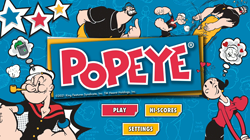 A popular nerd debate has always been who would win in a fight: Superman or Goku. Aside from the obvious problem with this dispute (as two sons of exploded planets that generally fight for justice, Superman and Goku would instantly become best friends and go to driving school together), the mere concept of such a battle ignores what makes Kal-El and Kakarot work. These two potential super friends are not powerful because they can push planets and fire energy beams, they are “strong” because they are eternally righteous and exist in a universe that will always narratively support their good deeds. Goku might lose a fighting tournament, and Superman might lose a footrace with the Flash, but when the world is threatened? When some monster from space is whipping out the human extinction attack? Then, and only then, will these heroes find the incredible strength necessary to save (and possibly revive) everyone they love. Goku and Superman were not first created with unfettered strength or super ventriloquism, they developed these powers as their rescues demanded it, and have since become “over 9,000” powerhouses with the rolling tumbleweed of continuity. Who would win in a fight between Superman and Goku? Whichever hero had a friend in danger first, and then they would miraculously become Super Saiyan Level Krypton or empowered by the Universe 7’s sun’s rays just enough to triumph and save the day.
A popular nerd debate has always been who would win in a fight: Superman or Goku. Aside from the obvious problem with this dispute (as two sons of exploded planets that generally fight for justice, Superman and Goku would instantly become best friends and go to driving school together), the mere concept of such a battle ignores what makes Kal-El and Kakarot work. These two potential super friends are not powerful because they can push planets and fire energy beams, they are “strong” because they are eternally righteous and exist in a universe that will always narratively support their good deeds. Goku might lose a fighting tournament, and Superman might lose a footrace with the Flash, but when the world is threatened? When some monster from space is whipping out the human extinction attack? Then, and only then, will these heroes find the incredible strength necessary to save (and possibly revive) everyone they love. Goku and Superman were not first created with unfettered strength or super ventriloquism, they developed these powers as their rescues demanded it, and have since become “over 9,000” powerhouses with the rolling tumbleweed of continuity. Who would win in a fight between Superman and Goku? Whichever hero had a friend in danger first, and then they would miraculously become Super Saiyan Level Krypton or empowered by the Universe 7’s sun’s rays just enough to triumph and save the day.
And it’s all moot, anyway, because Popeye would kick both of their asses. Popeye is the ur-hero of the last century.
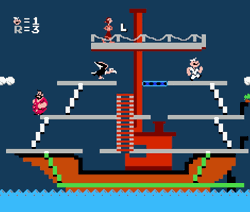 Popeye was introduced to the world nearly ten years before Clark Kent ever made the scene. In his initial appearance, Popeye was a sailor-side character that gained unfathomable luck by rubbing the hairs of Bernice the Whiffle Hen. This allowed Popeye to cheat at gambling (yes, having hen-derived luck would be considered outright fraud by most major casinos), and, more importantly, have enough luck to survive what would have been a fatal shooting. While the lesson of “do not cheat at gambling unless you can verify your own immortality” was an important one, Popeye inadvertently introduced his oft-imitated formula for popularity/victory right there at the start. As “lucky invincibility” gave way to “incredible strength”, Popeye would often find himself in a completely impossible situation, with the only key to solve the latest problem being a conveniently available can of spinach. Spinach wasn’t always the answer to Popeye’s problems, but back in the days of Thimble Theatre starring Popeye, a quick burst of overwhelming power would solve many Sea Hag or Toar the Caveman related issues.
Popeye was introduced to the world nearly ten years before Clark Kent ever made the scene. In his initial appearance, Popeye was a sailor-side character that gained unfathomable luck by rubbing the hairs of Bernice the Whiffle Hen. This allowed Popeye to cheat at gambling (yes, having hen-derived luck would be considered outright fraud by most major casinos), and, more importantly, have enough luck to survive what would have been a fatal shooting. While the lesson of “do not cheat at gambling unless you can verify your own immortality” was an important one, Popeye inadvertently introduced his oft-imitated formula for popularity/victory right there at the start. As “lucky invincibility” gave way to “incredible strength”, Popeye would often find himself in a completely impossible situation, with the only key to solve the latest problem being a conveniently available can of spinach. Spinach wasn’t always the answer to Popeye’s problems, but back in the days of Thimble Theatre starring Popeye, a quick burst of overwhelming power would solve many Sea Hag or Toar the Caveman related issues.
And then in 1932, King Features and Fleischer Studios teamed up to create the Popeye Theatrical Cartoons. For a solid 25 years, audiences watched shorts wherein Popeye would be trapped in an unwinnable position, but, at the last minute, our hero would down a can of spinach, grow muscles that looked way too cancerous to be healthy, and then wallop every problem in his path. Over and over again, Popeye would take a beating, seemingly be completely defeated, and then rally at the last moment with the help of one magical leafy green. And it was not just about strength for Popeye! Spinach would often confer hitherto unknown abilities upon our favorite sailor man, with at least a few cases where Popeye gained incredible smarts or acrobatic prowess. Was there an episode wherein Popeye instantly gained an understanding of Latin and proceeded to perform open heart surgery? No, but only because not enough people had heard of Daniel Hale Williams, and Max Fleischer didn’t want audiences to be confused. Operating skills aside, Popeye shorts reinforced incessantly that Popeye could do anything or defeat anybody just so long as he nabbed his favorite spinach within the final few moments of a conflict. Whether it was saving Olive Oyl or guaranteeing the safety of Sweat Pea, Popeye would always save the day.
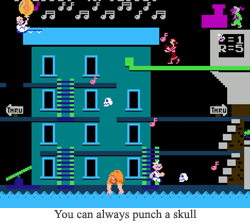 And can you even count how many heroes followed the template of Popeye? Put the sailor man in a sailor fuku and we’ve got Sailor Moon. Strip him down to his pants and you’ve got The Hulk with that last minute burst of anger. Hell, let Popeye be a little more chill, and your “spinach” could very well be Columbo saying, “just one more thing.” Popeye is the ur-hero because his modus operandi is perfect for our 20-40 minute dramas, whether they feature slow and congenial detectives or massive muscle monsters. And then when you get into the realm of videogame heroes…
And can you even count how many heroes followed the template of Popeye? Put the sailor man in a sailor fuku and we’ve got Sailor Moon. Strip him down to his pants and you’ve got The Hulk with that last minute burst of anger. Hell, let Popeye be a little more chill, and your “spinach” could very well be Columbo saying, “just one more thing.” Popeye is the ur-hero because his modus operandi is perfect for our 20-40 minute dramas, whether they feature slow and congenial detectives or massive muscle monsters. And then when you get into the realm of videogame heroes…
At their very core, videogames are all about “underdog” humans triumphing over “advanced” machines. That is all baloney, of course, as videogames have been designed to be won for decades. But the player has to feel like there is a challenge. The player must think that Link could never un-conquer a kingdom under the thumb of a pigman’s army, or that there is no possible way this little blue hedgehog could save his friends from a robotic invasion. The odds must be against you. The enemy must be seemingly unsurmountable. How are you going to get out of this one? Well, maybe you’ll find some spinach at just the right moment…
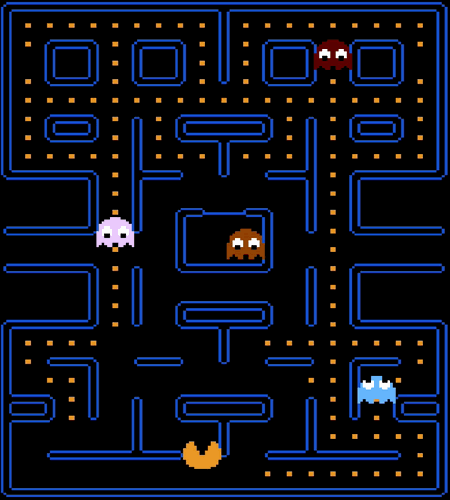
And then there’s Mario. Mario and Donkey Kong were famously created because Shigeru Miyamoto could not immediately obtain the Popeye license, and a new protagonist/antagonist duo had to be born. The proud pummeler became a pudgy plumber, and the big gorilla of an antagonist became a literal gorilla (and the Olive Oyl to Pauline transition was… succinct). Other than that? Donkey Kong could be Popeye (or it would be titled “Bluto”, I guess). The spinach to hammer transition is apparent, and, when Miyamoto finally got his hands on Popeye for the seminal arcade/NES hit, very little had changed. Popeye scampers around collecting hearts, letters, and musical notes while Bluto stomps about attempting to ruin Popeye’s day. The only real difference between this and Donkey Kong is that the Sea Hag becomes the stationary “monkey” that tosses off random projectiles, and Bluto fills the role of the sentient fireball that stalks our hero. But the fact that Popeye very well could be Mario neatly summarizes how the Mario/Bowser dynamic is something that was established nearly a century ago, and the only real change has been a reliance on fungus over spinach. Popeye is Mario.
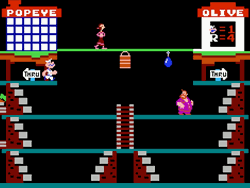 It is fun to imagine epic battles between western superheroes and anime monkey gods, but when you get down to the mundane minutia of such a melee, you find that it is mirror matches all the way down. Goku, Superman, and even Mario owe their existence to a comic strip character from before the Vatican’s (technical) existence. It’s all Popeye, just with different flavors of spinach.
It is fun to imagine epic battles between western superheroes and anime monkey gods, but when you get down to the mundane minutia of such a melee, you find that it is mirror matches all the way down. Goku, Superman, and even Mario owe their existence to a comic strip character from before the Vatican’s (technical) existence. It’s all Popeye, just with different flavors of spinach.
Heroes of the last century? They am what they am.
FGC #628 Popeye
- System: This article is primarily inspired by the original Popeye game that appeared in arcades and on the Nintendo Entertainment System. Just recently, however, there was a 3-D “upgrade” of the Popeye arcade game for the Nintendo Switch. Note the extreme use of quotes on “upgrade” there. Atari 2600, Colecovision, and Commodore 64 versions are all also in circulation (assuming it is the early 80s).
- Number of players: Two player alternating. Everyone can be Popeye!
- Maybe actually talk about the game for a second: This is a good early arcade game. You have concise goals, obvious antagonists, and the ol’ spinach allows for some dramatic changes in fortune. I will maintain that Brutus is a little too powerful at the start of the arcade game (his “gotcha” grabs from other levels are always going to eat up a quarter or two), but the NES version seems balanced for a fun play session of fifteen minutes or so.
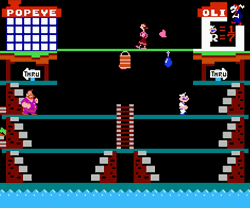 Favorite Thing You Can Make Happen Once Every 7,000 Plays: Punching the barrel directly onto Bluto and trapping him for a few seconds is the most satisfying thing you can do in an arcade game. It requires absolutely meticulous timing and infinite luck, but when you nail it? Best feeling in the world.
Favorite Thing You Can Make Happen Once Every 7,000 Plays: Punching the barrel directly onto Bluto and trapping him for a few seconds is the most satisfying thing you can do in an arcade game. It requires absolutely meticulous timing and infinite luck, but when you nail it? Best feeling in the world.- Goggle Bob Fact: A Popeye arcade cabinet used to sit at the base of the Sombrero Tower in South of the Border for years… Or at least the years I would go on family vacations as a child. I never got to play Popeye, because we were inevitably just pitstopping there, and it was time to ignore videogames and get back in the car for ten hours, Wee Goggle Bob. I think I covet this game more as a result…
- Port-O-Call: The Switch version of Popeye technically has the same gameplay (run around three levels on a loop, collect trinkets tossed by Olive Oyl, occasionally eat spinach), but the advent of 3-D environments dramatically changes the game. Bluto is an omnipresent threat on a single screen, 2-D plane, but it is rare to feel like he is in the same area code when you have significantly more room to maneuver. Switch Popeye somehow still works because of the classic gameplay loop of “run around and grab things”, but the cat ‘n mouse game of the original is markedly neutered. You’d be better off spending your quarters elsewhere…
- Did you know? Popeye doesn’t have a jump button. He doesn’t need a jump button, but it is weird that this title completely eschewed the action that made Jump Man a star.
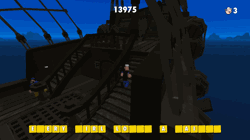 Would I play again: Hey, why not? It is a fun time, and, while I may not play it until my eyes bleed like some arcade titles (hi, Ms. Pac-Man), it is an enjoyable experience. Popeye may be every hero, but it is good to see he got at least one good game all his own.
Would I play again: Hey, why not? It is a fun time, and, while I may not play it until my eyes bleed like some arcade titles (hi, Ms. Pac-Man), it is an enjoyable experience. Popeye may be every hero, but it is good to see he got at least one good game all his own.
What’s next? Random ROB has chosen… Radical Dreamers! And that has nothing to do with the rerelease I have been anticipating for the last twenty years! I swear! Please look forward to it!